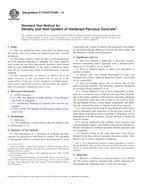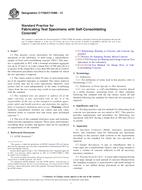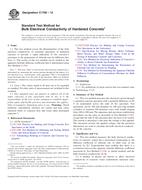We need your consent to use the individual data so that you can see information about your interests, among other things. Click "OK" to give your consent.
ASTM C1621/C1621M-14
Standard Test Method for Passing Ability of Self-Consolidating Concrete by J-Ring
STANDARD published on 1.4.2014
The information about the standard:
Designation standards: ASTM C1621/C1621M-14
Note: WITHDRAWN
Publication date standards: 1.4.2014
SKU: NS-12055
The number of pages: 5
Approximate weight : 15 g (0.03 lbs)
Country: American technical standard
Category: Technical standards ASTM
The category - similar standards:
Annotation of standard text ASTM C1621/C1621M-14 :
Keywords:
halo, j-ring, j-ring flow, passing ability self-consolidating concrete, slump flow, spread, ICS Number Code 91.100.30 (Concrete and concrete products)
Additional information
| Significance and Use | ||||||||||
|
5.1 This test method provides a procedure to determine the passing ability of self-consolidating concrete. This test method is applicable for laboratory use in comparing the passing ability of different concrete mixtures. It is also applicable in the field as a quality control test. 5.2 The difference between the slump flow and J-Ring flow is an indication of the passing ability of the concrete. A difference less than 25 mm [1 in.] indicates good passing ability and a difference greater than 50 mm [2 in.] indicates poor passing ability. The orientation of the mold for the J-Ring test and for the slump flow test without the J-Ring shall be the same. 5.3 This test method is limited to self-consolidating concrete with nominal maximum size of aggregate of up to 25 mm [1 in.]. |
||||||||||
| 1. Scope | ||||||||||
|
1.1 This test method covers determination of the passing ability of self-consolidating concrete (SCC) by using the J-Ring in combination with a mold. 1.2 The values stated in either SI units or inch-pound units are to be regarded separately as standard. The values stated in each system may not be exact equivalents; therefore, each system shall be used independently of the other. Combining values from the two systems may result in non-conformance with the standard. 1.3 The text of this standard references notes and footnotes that provide explanatory material. These notes and footnotes (excluding those in tables and figures) shall not be considered as requirements of the standard. 1.4 This standard does not purport to address all of the safety concerns, if any, associated with its use. It is the responsibility of the user of this standard to establish appropriate safety and health practices and determine the applicability of regulatory limitations prior to use. (Warning—Fresh hydraulic cementitious mixtures are caustic and may cause chemical burns to skin and tissue upon prolonged exposure.2) |
||||||||||
| 2. Referenced Documents | ||||||||||
|
Similar standards:
Historical
15.12.2010
Historical
1.11.2013
Historical
1.5.2012
Historical
1.8.2013
Historical
1.6.2013
Historical
1.1.2012
We recommend:
Technical standards updating
Do you want to make sure you use only the valid technical standards?
We can offer you a solution which will provide you a monthly overview concerning the updating of standards which you use.
Would you like to know more? Look at this page.



 ASTM C1740-10
ASTM C1740-10 ASTM C1747/C1747M-13..
ASTM C1747/C1747M-13.. ASTM C1754/C1754M-12..
ASTM C1754/C1754M-12.. ASTM C1757-13
ASTM C1757-13 ASTM C1758/C1758M-13..
ASTM C1758/C1758M-13.. ASTM C1760-12
ASTM C1760-12
 Cookies
Cookies
